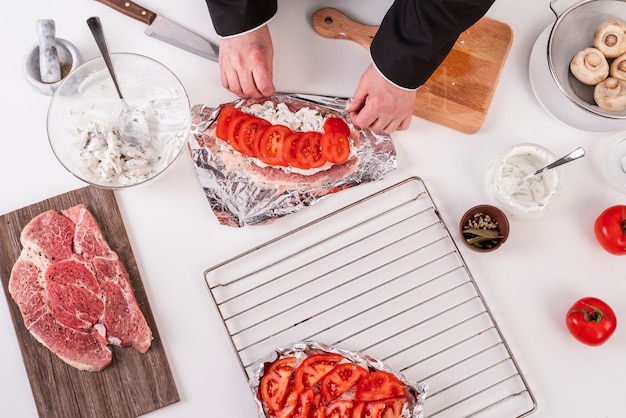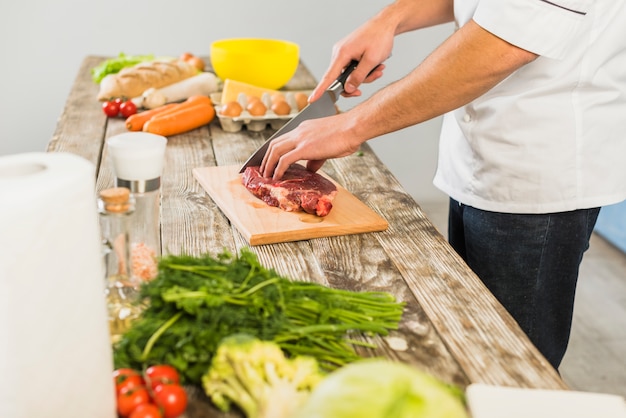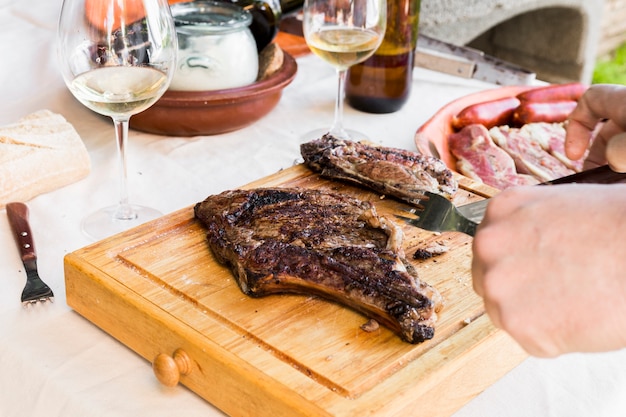Let's talk about beef steaks, those glorious slices of protein that can make or break a meal. I've been grilling and pan-frying them for years, and there's nothing quite like a perfectly cooked steak. But achieving that perfect balance of sear, pinkness, and tenderness can be a challenge. That's why understanding cooking times is essential, and that's what we're going to delve into today.
(Part 1) The Foundation: Choosing Your Steak

The foundation of a great steak starts with the cut. You wouldn't build a house on a weak foundation, and you shouldn't expect a perfect steak from an inferior cut. There's a whole world of beef cuts out there, each with its own unique flavour and texture. For the best results, you want a cut with a good amount of marbling. That's the fat that runs through the muscle, giving it flavour and tenderness. Think of it like a well-marbled cake—the fat adds richness and moisture.
A Deeper Dive into steak cuts
While there are many cuts to choose from, certain ones are particularly well-suited for grilling or pan-frying. Here are a few of my favourites, each with its own personality:
- Sirloin: A versatile cut that's equally at home on the grill or in a pan. It boasts good marbling and a rich flavour. I find that it works really well with a simple seasoning of salt and pepper.
- Rib-eye: A crowd-pleaser known for its beautiful marbling and juicy texture. It's a bit pricier, but for special occasions, it's worth the splurge. Think of it as the star of the show, perfect for a celebratory dinner.
- new york strip: Leaner than the rib-eye, with a more pronounced flavour. It's a bit tougher, but when cooked to medium-rare, it can be wonderfully tender and flavourful. It's a great option for those who prefer a leaner steak.
- filet mignon: The most tender cut of beef, perfect for a luxurious meal. It's very lean, so it cooks quickly and doesn't need to be cooked for long. It's often described as melting in your mouth, which is why it's so popular for special occasions.
(Part 2) The Cooking Landscape: Grilling vs. Pan-Frying

Once you’ve chosen your steak, it's time to decide how you want to cook it. The two main approaches are grilling and pan-frying, each offering distinct advantages and flavours.
Grilling: The Outdoor Feast
Grilling is the classic way to cook a steak, imparting that beautiful sear and smoky flavour. I love the rustic charm of cooking over charcoal, but gas grills can produce excellent results as well. Just make sure your grill is nice and hot—we want to sear those steaks, not steam them.
- Get the Grill Hot: You want your grill to be around 500°F (260°C). This high heat creates a fantastic sear without burning the steak.
- Clean the Grill: A clean grill is a happy grill! Give it a good scrub with a grill brush to remove any leftover food or debris. It's a good practice to pre-heat your grill with the lid closed to help burn off any remaining bits.
- Oil the Grill Grates: A little oil on the grill grates will help prevent your steak from sticking, allowing for a beautiful sear.
Pan-Frying: The Indoor Alternative
If you don't have a grill or are cooking indoors, pan-frying is an excellent alternative. A cast-iron pan is ideal because it retains heat incredibly well, leading to a beautiful sear. But any heavy-bottomed pan will work. Remember, hot is the key here!
- Heat the Pan: Heat your pan over medium-high heat until it's really hot. You should be able to feel the heat radiating from the pan when you hold your hand a few inches above it.
- Oil the Pan: Add a tablespoon or two of oil to the pan and let it heat up. You want the oil to shimmer just before you add your steak.
- Season the Steak: Season your steak liberally with salt and pepper. Don't be shy with the salt! It will enhance the flavour of the steak.
(Part 3) Doneness Levels: Understanding Your Beef

Now, we come to the heart of the matter: doneness levels. Everyone has their preference, but knowing how to achieve each level is crucial to ensuring a delicious steak.
The Spectrum of Doneness
There are four main doneness levels, each with its own distinct texture and flavour:
- Rare: The centre of the steak is cool and red, with a juicy and tender texture. Think of it as a perfectly bloomed flower—a beautiful, vibrant red.
- Medium-rare: The centre of the steak is warm and pink, with a slightly firmer texture than rare. It's like a beautiful blush, a touch of pink to brighten the flavour.
- Medium: The centre of the steak is warm and pink, with a firm texture. It's a more familiar doneness, a nice balance between pink and brown.
- Well-done: The centre of the steak is hot and brown, with a firm texture. This is for those who prefer their steak fully cooked, with a consistent, even brown throughout.
(Part 4) Steak Thickness and Cooking Times: A Guide to Precision
Okay, now for the moment of truth: cooking times. Each steak is different, and the thickness plays a crucial role in determining how long it takes to cook. Think of it like a puzzle—each piece has its own size and shape, and we need to find the right time to fit it perfectly into the picture.
Steak Thickness and Cooking Times: A Handy Table
I've created a handy table to guide you through the estimated cooking times for different steak thicknesses at each doneness level. Keep in mind that these are just estimates, and you might need to adjust the cooking times based on your specific steak and your preferred level of doneness.
| Steak Thickness | Rare | Medium-rare | Medium | Well-done |
|---|---|---|---|---|
| 1 inch (2.5 cm) | 2-3 minutes per side | 3-4 minutes per side | 4-5 minutes per side | 5-6 minutes per side |
| 1.5 inches (3.8 cm) | 3-4 minutes per side | 4-5 minutes per side | 5-6 minutes per side | 6-7 minutes per side |
| 2 inches (5 cm) | 4-5 minutes per side | 5-6 minutes per side | 6-7 minutes per side | 7-8 minutes per side |
Remember, these are just guidelines. It's always a good idea to use a meat thermometer to check the internal temperature of your steak. A meat thermometer is a chef's best friend, ensuring that your steak is cooked to your exact preference.
(Part 5) The Importance of Resting: Allowing Flavours to Settle
You've cooked your steak perfectly, now it's time to let it rest! Why? Because resting allows the juices to redistribute throughout the steak, resulting in a more tender and flavorful final product. Think of it like letting the flavours settle in, making the steak more harmonious.
Let your steak rest for 5-10 minutes before slicing and serving. Cover it loosely with foil to keep it warm and let those juices redistribute.
(Part 6) mastering the sear: The Key to a Delicious Steak
The sear is what truly takes a steak from good to amazing. It gives it that beautiful brown crust and adds a layer of flavour. To get the perfect sear, you need to have your grill or pan really hot. Imagine it as the first impression of your steak, a beautiful, crispy, flavourful introduction.
Achieving the Perfect Sear:
Here are some tips for achieving that irresistible sear:
- Heat Your Grill or Pan: Make sure your grill or pan is smoking hot before adding the steak. The hotter it is, the better the sear.
- Don’t Overcrowd the Pan: Give your steaks space to cook evenly. Don't overcrowd the pan or grill—you want to ensure that each steak gets direct contact with the heat.
- Don't Move the Steak Too Early: Let the steak sit for a few minutes before flipping it. This will help create a nice sear. Don't rush the process!
- Flip Only Once: Flip the steak only once to create a crust on both sides. This minimizes the disturbance and allows the steak to cook evenly.
(Part 7) Beyond the Basics: Elevating Your Steak Game
Now, you've got the basics down pat. Let's talk about taking your steak game to the next level. It's time to add some personality, some flair, to your steak creations.
Adding Flavor:
You can elevate the flavour of your steak by using marinades, rubs, or sauces. Here are a few ideas to spark your culinary imagination:
- Marinate it: A marinade can infuse your steak with a depth of flavour. Try a simple marinade of soy sauce, garlic, ginger, and honey for a sweet and savoury kick.
- Rub it: A dry rub can add a smoky, spicy flavour to your steak. Try a combination of paprika, cumin, garlic powder, and onion powder for a bold and aromatic experience.
- Sauce it: A good sauce can elevate a steak to new heights. Try a classic béarnaise sauce, rich red wine sauce, or a simple chimichurri sauce for a fresh and vibrant touch.
(Part 8) FAQs: Your Steak Questions Answered
I get a lot of questions about steak, so I've compiled a list of the most common ones to help you navigate the world of beef.
FAQs:
- What's the best way to tell if a steak is cooked to the right doneness?
The most reliable way to tell is to use a meat thermometer. Here's a quick guide to internal temperatures for different doneness levels:
- Rare: 125-130°F (52-54°C)
- Medium-rare: 130-135°F (54-57°C)
- Medium: 140-145°F (60-63°C)
- Well-done: 150-155°F (65-68°C)
If you don't have a meat thermometer, you can also check for doneness by pressing on the steak. A rare steak will feel soft and spongy, while a well-done steak will feel firm.
- How long should I let my steak rest before slicing?
Let your steak rest for 5-10 minutes before slicing. This allows the juices to redistribute throughout the steak, resulting in a more tender and flavorful final product.
- What's the best way to cut a steak?
Cut the steak against the grain. This will make it easier to chew and more tender. Think of it like cutting through the muscle fibres, making it easier to enjoy.
- Can I freeze steak?
Yes, you can freeze steak. It's best to freeze it in a freezer-safe bag or container. Just be sure to thaw it in the refrigerator for 24 hours before cooking. This slow thawing helps preserve the quality of the steak.
- What's the best way to reheat a steak?
You can reheat a steak in a skillet over medium heat. You can also reheat it in the oven at 350°F (175°C) for about 10 minutes. For best results, try to reheat it as quickly as possible to prevent it from drying out.
I hope this guide has helped you understand the nuances of cooking a perfect steak. So go forth, experiment, and enjoy! And remember, the most important thing is to cook it to your liking. Happy grilling, pan-frying, and steak-eating!
Everyone is watching

How to Cook Frozen Lobster Tails Perfectly: A Step-by-Step Guide
RecipesLobster. Just the word conjures up images of lavish meals, special occasions, and a taste of luxury. But let's...

Pigs in a Blanket Cooking Time: How Long to Bake for Perfect Results
RecipesAh, pigs in a blanket. Just the name conjures up images of those delightful little parcels of crispy pastry en...

Pork Fillet Cooking Time: How Long to Cook It Perfectly
RecipesPork fillet, or tenderloin as it's sometimes called, is a real favourite in our house. It's so versatile, and...

The Ultimate Guide to Tender, Juicy Pulled Pork
RecipesRight, let's talk pulled pork. It's one of those dishes that just screams "comfort food," doesn't it? I mean...

The Ultimate Guide to Cooking Delicious Frankfurters
RecipesLet's face it, we all love a good frankfurter. It's a classic, simple, and always satisfying. But let's be rea...
